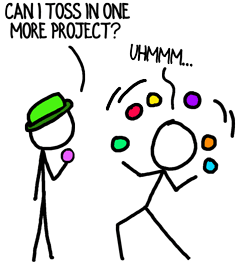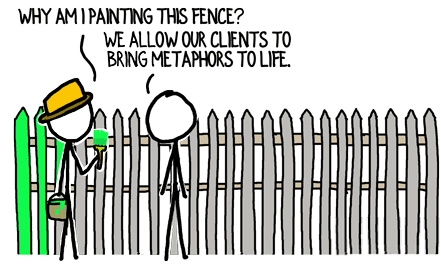Ron “Cherry Top” Ronson, CEO of HunkaChunk Chocolate Company, wants to hire your consulting firm to work your magic, but you’re hesitating. Why? Because you’re already busy. Beyond busy. As a firm you’re running flat out and working overtime.
On one hand, you fiercely want the HunkaChunk project. Heck, you’ve been courting ol’ Cherry for years. In terms of capacity, though, the timing just couldn’t be worse.

If only there was another resource you could turn to. There is.
Your clients.
Consulting firms treat projects like Fred Flintstone’s car, with consultants’ legs pushing the heavy load while clients relax for the ride.
That’s hard work. Too hard. Tell Cherry Top and your other clients to put their feet down and push!
You can increase your consulting firm’s capacity, reduce over-utilization and maintain (or increase) your fees by enrolling your clients in the hard work of delivering a successful project outcome. Yabba dabba doo!
Of course, you can’t unceremoniously offload work to your clients. That would be tough to pull off, threaten your relationships and raise questions about your fees.
Instead, enroll your clients in your consulting engagements, revealing the wisdom, benefit and value of their active participation.
You’re not shirking the work, you’re graciously inviting them to gain more from their projects by performing vital tasks. You’re Tom Sawyer offering your clients the opportunity to pay you for privilege of painting their own fence.
You can transfer work to your clients at numerous points during your consulting engagements. Below are a few examples:
.
Work Sessions
In work sessions your team and your client’s team roll up your collective sleeves to tackle large chunks of your consulting project. Work sessions are the perfect mechanism for sharing the load.
Plus, you’ll develop superior outputs and raise the odds your client will adopt your solution.
Research and Analysis
If your project involves any scripted research, enlist an administrative person from your client’s staff to lead some (or all) of the calls.
Similarly, data cleaning and basic analysis can be tackled by your client’s junior analysts as long as you provide a template. (You’ll want to keep your proprietary analyses close to the vest, of course.)

Drafting Deliverables
There’s nothing wrong with saying to your client, “You take a first stab at this, then I’ll build on it” for parts of your consulting project. Particularly if you give directions, guidance, a framework and/or a template. Think of it as training the client to do it themselves next time, with your IP improving the outcome.
Similarly, many clients want a final consulting deliverable or presentation on their own template. Who better to wrestle your draft presentation into final form than someone on your client’s staff?
Presentations
Give your consulting client a role in any presentation to a broad audience. As with work sessions, sharing the spotlight can lighten your load while improving client buy-in and satisfaction.
Testing and QA
If your consulting firm’s solutions involve any type of technology or implementation, chances are a fair amount of QA and testing are involved. Even non-tech solutions often need to be stress-tested to ensure your assumptions and execution are sound.
Testing is laborious, grinding, capacity-hogging work, and your clients can absolutely join in the fun. Since they’ll be living with the ultimate output, it makes sense that they participate in testing that output while the project is still active.
How else do your consulting clients pull some of the weight on their projects?
Text and images are © 2024 David A. Fields, all rights reserved.

 David A. Fields Consulting Group
David A. Fields Consulting Group 

In my experience, the client team members take too long and deliver just enough to say they did it, but not the quality you need. And when the deadline for the next review comes around, and the work is half baked, it’s hard to hold the client team members accountable. They don’t report to you and they know it.
I am actually weary of situations where the client offers to help in return for reduced fee or shortened time lines.
Thoughts?
Vivek Soman.
That’s a fair concern, Vivek. Client work can be pretty bad! (That’s why they need us, after all.) I’ve found that giving them tightly defined tasks, and well-designed templates help. Clear timelines, with calls/meetings on the calendar also keep them on track.
You’ve raised a great point for discussion, Vivek.
Aside from the quality issue that Vivek raised, there’s also the fact that clients often hire consultants /because/ they themselves don’t have the capacity to do even parts of the project themselves. In that situation, a consultant is hard-pressed to find anyone who could/would want to add any piece of the effort to their maxed-out workload, and none of their bosses would be willing to reprioritize their employees’ day to help you (“but that’s what we brought in the consultant(s) to do!”). It’s often hard enough to get anyone to attend key meetings or provide the necessary data/inputs…
Last not least, you’ll need to carefully manage perceptions about “asking for their watch to tell them the time”. Thanks, David, for a few hints at ways to make your suggestions more palatable, e.g. by emphasizing the skills transfer and improved quality/buy-in.
Part of this depends on the type of consulting you’re doing; however, from experience I can say that all my clients–particularly inside boutique consulting firms–are VERY busy. Nevertheless, I’m able to engage them in the work. It’s to their advantage to participate. Yes, it reduces my workload (usually), but it also creates a better outcome.
Thanks for your perspective, Franziska. Your insights are always high value.
David, one of the best things that I love asking my clients to do is the actual scheduling of meetings with people in their organization. They have access to calendars and people and will inevitably get a better and faster response than me. And it is a HUGE time saver for me.
In fact, one client has engaged me several times and is now taking on more of the meetings and presentation creation, and I am handling the behind-the-scenes and more complicated support she needs. Win-win!
Terrific example of offloading work, Carol. Scheduling is a “simple” task that can eat up resources quickly. You’re right that your client’s in a better position to take care of that. Great addition, Carol!
We try to get the client involved in the analysis, determining options, and framing recommendations. While we may be doing a lot of the heavy lifting on this, having the client involved inevitably increases buy-in and improves the overall relationship with clients… and often leads to additional opportunities.
Excellent case study of involving the client in their own projects, Jeff. As you eloquently point out, involving your client in the work increases the bond between them and your consulting firm, and often lifts the odds of winning follow-on work.
Thanks for providing the example, Jeff.
David, I recently stumbled on this technique through no fault of my own. In this instance, the client had all of the data I needed to complete an assessment. With the time constraints we had put in place, the most efficient path was to have the client to provide the updates. So I just asked them to do so. I *could* have done the work too, but it would have been more costly in terms of time (identifying the right people to interview, framing the questions, conducting the interviews, etc.). On a lighter note, I couldn’t help thinking of the Stone Soup fable after reading your post!
Excellent case study, David. Clients can generally pitch in more than we (initially) give them credit for, and it’s to everyone’s benefit to find a way for them to contribute their sweat to the effort.
Stone soup is a good parallel. Originally, the article also referenced Tom Sawyer’s fence, which is along the same lines, but I took that reference out except for the illustration.
I’m glad you shared your experience with other readers, David!